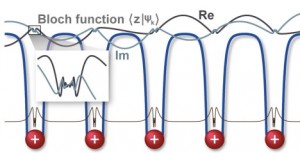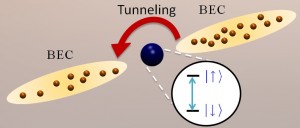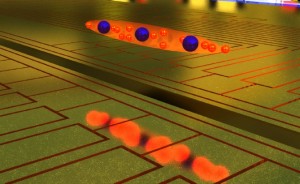We are always looking for talented post-docs and PhD students. If you are interested, just send me an email.
If you want to do your Master thesis in our group just send me an email. You can also check out the following available projects:
Master project: Development and implementation of a hybrid atom-ion trap
Experiments with ultracold atoms and ions allow us to study quantum phenomena in the laboratory, such as Bose-Einstein condensation, quantum entanglement and quantum phase transitions. Although a lot of work has been done on the systems of ions and atoms separately, combining the two and studying their interactions in the quantum regime is a relatively new field [1]. A new project in the AG Quantum is aimed at studying the interaction between 174Yb+ ions and a degenerate gas of fermionic 6Li atoms. This system has stunning similarities to a natural crystalline solid and should feature solid state phenomena such as fermion-phonon coupling and quantum phase transitions [2]. This could allow us to use the system as a quantum simulator of solids and to study the dynamics of many-body atom-ion systems [3].
A Master- or Diplomarbeit would consist of designing and developing a combined atom-ion trap. Our group has a lot of experience with the technologies of atom and ion trapping, but combining the two makes high demands on the trapping system, such as in optical access, vacuum demands and the necessity of using high magnetic fields and high power laser beams. An array of ion trapping electrodes will allow trapping ions with equidistant spacing. The work would require both field simulations of the ion trap, trajectory simulations of atom-ion interactions and a lot of hands-on work in vacuum design and trap assembly. In the meantime the laser system will be set up for cooling and trapping the atoms and ions. The work will be performed under direct supervision of one PhD student and Dr. Rene Gerritsma.
↑ Calculated Bloch waves in the hybid system, showing close analogy to natural solids [2].Literature:
[1] Christoph Zipkes, Stefan Palzer, Carlo Sias & Michael Köhl, Nature 464, 388-391 (2010).
[2] U. Bissbort et al., Physical Review Letters 111, 080501 (2013).
[3] R. Gerritsma et al.,Physical Review Letters 109, 080402 (2012).
Master project: Bose-Einstein condensation in a hybrid atom-ion microtrap
Trapped ions allow for studying quantum entanglement and small-scale quantum computing. On the quest for scalable quantum computing, ion traps are being scaled down to miniature dimensions. In the AG Quantum, we have set up an experiment to integrate such ion microtraps with ultracold neutral atoms [1]. The goal of this experiment is to study situations in which trapped ions control the many-body quantum dynamics of clouds of ultracold atoms. As an example, trapped ions can be used to tune the tunneling of atoms in a Josephson junction. This may lead to large entangled atom-ion cat states [2]. We are also interested in studying atom-ion scattering in nearly 1-dimensional configurations and in studying the effect of introducing single ion impurities [3]. Another aspect that is of much interest for ion trap quantum computing is the possibility to use ultracold atoms as a refrigerator gas for the ions, preventing them from heating up during the quantum operations.
↑ An atomic Josephson junction in which the tunneling is controlled by the spin of a single trapped ion. The dynamics can lead to large scale atom-ion entanglement and superpositions of tunneling and atomic self-trapping.In the last year, we have designed and developed a miniature ion trap that can be combined with magnetically trapped 87Rb atoms and have started to assemble the system. A Master- or Diplomarbeit would consist of producing a Bose- Einstein condensation in this trap. The work will involve finalizing the vacuum setup, setting up an atomic imaging system with computer control and optimizing the atomic cooling process. The project will be supervised by one PhD student and Dr. Rene Gerritsma and is performed in collaboration with the group of Ferdinand Schmidt-Kaler.
↑ An atomic cloud (red) can be overlapped with a small crystal of ions (blue) to study 1-dimensional dynamics. The ions are trapped in a planar Paul trap, of which the electrodes are shown. The atoms are trapped magnetically by integrated electromagnets.Literature:
[1] C. Zipkes et al., Nature 464, 388-391 (2010).
[2] R. Gerritsma et al.,Physical Review Letters 109, 080402 (2012).
[3] J. Goold et al., Phys. Rev. A, 81, 041601(R) (2010).


